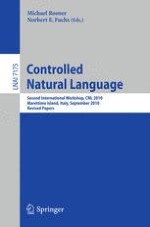2012 | Book
Controlled Natural Language
Second International Workshop, CNL 2010, Marettimo Island, Italy, September 13-15, 2010. Revised Papers
Editors: Michael Rosner, Norbert E. Fuchs
Publisher: Springer Berlin Heidelberg
Book Series : Lecture Notes in Computer Science
